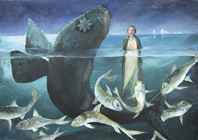New Planetary Bodies, Millennium Planets and other Power Points in Space
Centaurs | Goddess Asteroids/Dwarf Planets | Other Power Points
Scattered Disk Objects
SEDNA
In November 2003 a new and very far out celestial body was discovered and named Sedna after the Inuit goddess of the icy Arctic seas. Sedna is nothing like anything that has been seen before and according to her discoverer, Mike Brown, shouldn't even be there. Her extreme elliptical orbit doesn't make sense unless there is another massive, yet to be seen, object out there gravitationally anchoring her in place. Sedna orbits close to the Orrt cloud, three times further out than Pluto and takes approximately 11,000 years to orbit the sun.
Sedna's mythology is rich and varied. Here is the essence of her story – Sedna was a beautiful Inuit woman who was courted by many suitors, all of whom she rejected. She did however marry a dog, thrown at her by one disgruntled suitor, and gave birth to pups and babes alike. The dog was loyal and caring of his offspring but Sedna's furious father put stones in the dog's pack and drowned him. Dogs are thought to guard the entrance to the Underworld and accompany souls through the passage of death. To the Inuit dogs symbolize faithfulness to one's own spirit, so Sedna's union with one was a mark of her independence and individuation.
 Later Sedna is tricked into accepting the disguised spirit of a fulmar (an arctic petrel sea bird) and ended up trapped on a desolate icy island. Her father rescued her but in the ensuing storm, created by the enraged fulmar, he threw her overboard to save himself. When Sedna grasped the side of the kayak her father chopped off her frozen fingers with an ax. As they fell back into the sea Sedna's fingers became sea creatures – seals, whales, polar bears, fish, dolphins and walruses. Sedna sunk to the bottom of the ocean, was guarded there by her faithful dog-husband and became a powerful goddess of the ocean. Sedna is believed to be the one who feeds the Inuit people with her abundance of sea creatures but she can also be known to withhold her bounty and starve those she is offended by.
Later Sedna is tricked into accepting the disguised spirit of a fulmar (an arctic petrel sea bird) and ended up trapped on a desolate icy island. Her father rescued her but in the ensuing storm, created by the enraged fulmar, he threw her overboard to save himself. When Sedna grasped the side of the kayak her father chopped off her frozen fingers with an ax. As they fell back into the sea Sedna's fingers became sea creatures – seals, whales, polar bears, fish, dolphins and walruses. Sedna sunk to the bottom of the ocean, was guarded there by her faithful dog-husband and became a powerful goddess of the ocean. Sedna is believed to be the one who feeds the Inuit people with her abundance of sea creatures but she can also be known to withhold her bounty and starve those she is offended by.
Mythologist Dr. Kathleen Jenks says about Sedna "When victimisation moves to the goddess-level as it does with Sedna, it signals us that there's a depth of compassion for the abused. Sedna may come to represent an extreme terrain of the unconscious, one where issues of power, authority and respect for life do not separate from a respect for oneself." This shows the ultimate unifying force of Sedna, when refusing the role of victim and acting in one's own best interests leads to a redemptive transcendence or evolution onto another more expansive dimension of reality, ultimately benefiting all life.
Sedna's huge elliptical orbit means that she was at aphelion (farthest point from the sun) thousands of years ago. Since then she has been moving incrementally faster and will reach perihelion (point closest to the sun) in the year 2081. As Sedna travels through each sign for long periods of time she can be seen to reflect evolutionary changes in the human story. Sue Kientz in her book "There Are More Plutos" presents the following table of what has been happening during Sedna's past passages through Pisces and Aries, her present passage through Taurus, and the possible themes for humanity's future with Sedna in Gemini, then Cancer.
